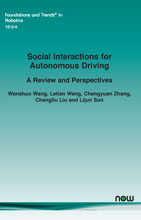Social Interactions for Autonomous Driving: A Review and Perspectives
By Wenshuo Wang, McGill University, Canada, wenshuo.wang@mcgill.ca | Letian Wang, University of Toronto, Canada, lt.wang@mail.utoronto.ca | Chengyuan Zhang, McGill University, Canada, chengyuan.zhang@mail.mcgill.ca | Changliu Liu, Carnegie Mellon University, USA, cliu6@andrew.cmu.edu | Lijun Sun, McGill University, Canada, lijun.sun@mcgill.ca
Abstract
No human drives a car in a vacuum; she/he must negotiate with other road users to achieve their goals in social traffic scenes. A rational human driver can interact with other road users in a socially-compatible way through implicit communications to complete their driving tasks smoothly in interaction-intensive, safety-critical environments. This monograph aims to review the existing approaches and theories to help understand and rethink the interactions among human drivers toward social autonomous driving. We take this survey to seek the answers to a series of fundamental questions: 1) What is social interaction in road traffic scenes? 2) How to measure and evaluate social interaction? 3) How to model and reveal the process of social interaction? 4) How do human drivers reach an implicit agreement and negotiate smoothly in social interaction? This monograph reviews various approaches to modeling and learning the social interactions between human drivers, ranging from optimization theory, deep learning, and graphical models to social force theory and behavioral and cognitive science. We also highlight some new directions, critical challenges, and opening questions for future research.
Social Interactions for Autonomous Driving: A Review and Perspectives
In real-world traffic, rational human drivers can make socially-compatible decisions in complex and crowded scenarios by efficiently negotiating with their surroundings using non-linguistic communications such as gesturing, deictics, and motion cues. Understanding the principles and rules of the dynamic interaction among human drivers in complex traffic scenes allows 1) generating diverse social driving behaviors that leverage beliefs and expectations about others’ actions or reactions; 2) predicting the future states of a scene with moving objects, which is essential to building probably safe intelligent vehicles with the capabilities of behavior prediction and potential collision detection; and 3) creating realistic driving simulators. However, this task is not trivial since various social factors exist along the driving interaction process, including social motivation, social perception, and social control. Generally, human driving behavior is compounded by human drivers’ social interactions and their physical interactions with the scene.
No human drives a car in a vacuum; she/he must negotiate with other road users to achieve their goals in social traffic scenes. A rational human driver can interact with other road users in a socially-compatible way through implicit communications to complete their driving tasks smoothly in interaction-intensive, safety-critical environments. This monograph reviews the existing approaches and theories to help understand and rethink the interactions among human drivers toward social autonomous driving. Fundamental questions which are covered include: 1) What is social interaction in road traffic scenes? 2) How to measure and evaluate social interaction? 3) How to model and reveal the process of social interaction? 4) How do human drivers reach an implicit agreement and negotiate smoothly in social interaction?
This monograph reviews various approaches to modeling and learning the social interactions between human drivers, ranging from optimization theory, deep learning, and graphical models to social force theory and behavioral and cognitive science. Also highlighted are some new directions, critical challenges, and opening questions for future research.
